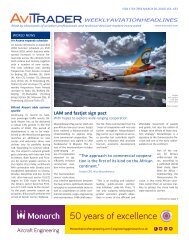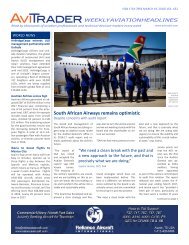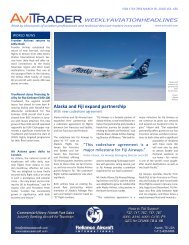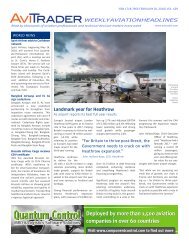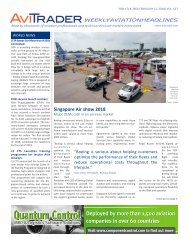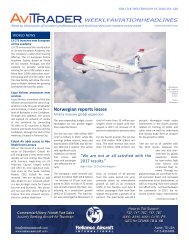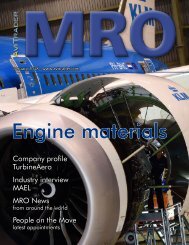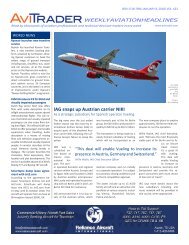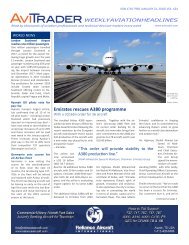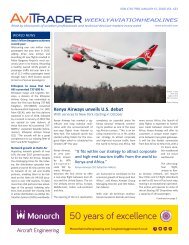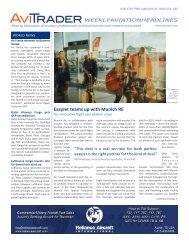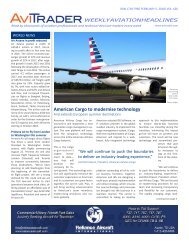AviTrader_Monthly_MRO_e-Magazine_2017-12
AviTrader_Monthly_MRO_e-Magazine_2017-12
AviTrader_Monthly_MRO_e-Magazine_2017-12
Create successful ePaper yourself
Turn your PDF publications into a flip-book with our unique Google optimized e-Paper software.
Cover story: <strong>MRO</strong> North America<br />
19<br />
Lund says the forecasted <strong>MRO</strong> contraction will derive from<br />
the delivery of new aircraft.<br />
Photo: Kellstrom Aerospace<br />
a qualified workforce,”<br />
Sokol notes.<br />
The shortage of skilled labour<br />
is in fact an on-going<br />
issue. Andrew Walmsley,<br />
President at Volo Aero<br />
<strong>MRO</strong> highlights that currently<br />
the challenge in<br />
north American <strong>MRO</strong> is<br />
the availability of skilled<br />
labour at an economic<br />
price point. “With the<br />
current high demand for<br />
new production and <strong>MRO</strong><br />
there are significant issues<br />
with ageing workforce,<br />
and labour rates and<br />
employment cost such as<br />
medical,” he states.<br />
There are no doubts that<br />
the US market has lower<br />
growth rates for passenger traffic and fleet growth than Asia and<br />
the Middle East, but it’s still a very large market, Walmsley reminds.<br />
“With logistics costs it makes sense to have <strong>MRO</strong> activity in<br />
the region that the aircraft operate in, assuming there is the necessary<br />
volume of work to support the demand.<br />
“Historically labour rates have been lower in Asia than North<br />
America, but with an increase in automation and efficiencies in<br />
process, plus the increase in cutting edge technology use in <strong>MRO</strong><br />
(with its escalation in costs), the biggest impact will be driven by the<br />
OEM’s business strategy,” says Walmsley.<br />
Kellstrom Aerospace has undergone a phase of aggressive expansion<br />
and diversification into every area of the aftermarket. With<br />
the expansion of its OEM distribution portfolio through the acquisition<br />
of Transaero Commercial business, to the purchase of The<br />
Aircraft Group (TAG) and Vortex Aviation with three hospital type<br />
engine shops in global locations and the establishment of Kellstrom<br />
Aerospace Technical Services (KATS) providing engineering<br />
services and engine management, Kellstrom seems well placed as<br />
an aftermarket partner<br />
for OEM’s airlines, lessors,<br />
financial institutions<br />
and <strong>MRO</strong>’s.<br />
Dany Kleiman, Group Vice President, <strong>MRO</strong> Services<br />
at AAR<br />
Lund says the key trends<br />
experienced in <strong>2017</strong> is<br />
the rise in <strong>MRO</strong> activities<br />
on legacy and newer<br />
generation aircraft and<br />
engines as airlines utilised<br />
the green time of<br />
assets. “Airlines decision<br />
to continue operations<br />
of older aircraft has seen<br />
impacts on the aftermarket<br />
supply chain, particularly<br />
for suppliers based<br />
on aircraft and engine<br />
disassembly model, as<br />
fewer aircraft have been<br />
retired.”<br />
He adds that competition for the available assets that have been<br />
retired from airline fleets has also been affected by mid-to-end of<br />
life lessors purchasing assets to return to service and limiting the<br />
supply of used surplus inventory into the global supply chain.<br />
One of the most significant business highlights for AAR in <strong>2017</strong> has<br />
been the acquisition of two <strong>MRO</strong> facilities in Canada from Premier<br />
Aviation in September. The two facilities – one at Trois-Rivières Airport<br />
in Québec and the other at Windsor International Airport in<br />
Ontario – represent an expansion of AAR’s <strong>MRO</strong> network of five<br />
facilities in North America and extends its airframe maintenance of<br />
commercial aircraft outside the U.S. for the first time. “The acquisitions<br />
will help us meet our objectives of expanding service offerings<br />
to our current customers and form new relationships to grow our<br />
presence worldwide,” declares Kleiman.<br />
Although rising recently, jet fuel prices are still down approximately<br />
45% over the previous three year average. Kleiman feels lower jet<br />
fuel prices have incentivised airlines to delay phase outs of older<br />
fleets, which has led to additional opportunities for independent<br />
<strong>MRO</strong>s like AAR to provide heavy maintenance and modifications<br />
of legacy platforms to help airlines meet passenger expectations.<br />
Walmsley, says low fuel prices are still allowing the operation of<br />
older fleets which require higher maintenance needs, but for the<br />
larger carriers it is also allowing them to build a stronger balance<br />
sheet to fund replacement aircraft. “When we return to higher fuel<br />
costs and a change in the economic cycle it’s going to be the facilities<br />
focused on the legacy platforms that are going to significantly<br />
impacted.”<br />
Mr Cronin from MTU<br />
expects fuel prices to remain<br />
relatively stable in<br />
the mid-term. “Generally,<br />
there has been little<br />
to no impact from raising<br />
fuel prices in terms<br />
of airline results in North<br />
America, as traditionally,<br />
costs have been passed<br />
to passengers via ticket<br />
surcharges,” he observes.<br />
Cronin - The north American market has seen a revival<br />
of <strong>MRO</strong> and leasing demand for mature engine types.<br />
Photo: MTU<br />
In terms of <strong>MRO</strong>, he says<br />
low fuel prices tend to<br />
mean that mature engines<br />
continue being<br />
flown. “MTU Maintenance<br />
has a mature engine<br />
programme perfect<br />
for such engines, which<br />
incorporates our extensive<br />
repair capabilities, customised builds, leasing, teardown<br />
for parts and asset management services. The range of options<br />
is made possible by the amount of surplus material and engines<br />
available on the market – they can be used to reduce <strong>MRO</strong> costs<br />
or substitute shop visits.”<br />
The North American <strong>MRO</strong> market has always struggled with labour<br />
cost. As Moabery from GA Telesis indicates, with a booming<br />
economy, wages for skilled positions rise and it becomes more difficult<br />
for <strong>MRO</strong> companies to compete against low-wage countries<br />
in South America, Eastern Europe and Asia. Additionally, as the<br />
industry grows and more countries develop their airline industries,<br />
<strong>AviTrader</strong> <strong>MRO</strong> - December <strong>2017</strong>





